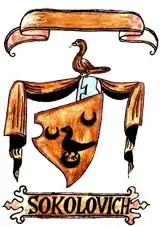Sokolović
Sokolović (Serbian Cyrillic: Соколовић, may also be transliterated as Sokolovic or Sokolovich) is a surname found among Serbs and Bosniaks. It derives from the Slavic word sokol, meaning "falcon" and literally means "son of the falcon". The Sokolović of the Sanjak of Herzegovina were called Sokoli and Sokullu-oğlu, by the Ottomans.[1] One of the coat of arms included in the Korenić-Neorić Armorial (1595) and the Fojnica Armorial (1675–88) claimed to be that of the "Sokolovich". The coat of arms most likely was attributed to the Sokolović of Glasinac (Sokolac region).[2]

Modern families
Bosnia and Herzegovina
The Sokolović in Foča have the slava of Mratindan,[3] the veneration of Serbian King Stefan Dečanski. The Sokolović of Foča, when interviewed by Vladimir Dedijer, said that they had left their ancestral home long ago.[4] Dedijer concluded that the Sokolović of Foča hailed from Korjenići.[4] Indeed, in the Late Middle Ages, families in Korjenići had the slava of Mratindan; among one of these families were surely the Sokolović of Foča.[4] The Mastilović in Gacko claimed that they were formerly named Sokolović, and that they were kin with those Sokolović in Foča, with whom they share the slava, and they claimed that Mehmed-paša Sokolović was one their ancestors.[3] A Sima Mastilović was mentioned in a document of the Piva Monastery from 1569; this points to that Sokolović was used much earlier than that.[3] The Kojović and Djaić in Čičevo near Trebinje also descend from the Sokolović in Foča, and have the slava of Mratindan.[5]
Petar Rađenović's anthropological work Bjelajsko Polje i Bravsko (1925) mentioned a Sokolović family in the Muslim village of Bjelaj, Bosanski Petrovac, as one of three Serb families, which had in 1921 settled from Ripač; they have the slava of Đurđevdan, and hail from Čajniče, and were earlier surnamed Glođajić.[6]
Serbia
In the period of 1920–31, Serb and other South Slavic families of the Kingdom of Hungary (and Serbian-Hungarian Baranya-Baja Republic) were given the option to leave Hungary for the Kingdom of Yugoslavia, and thereby change citizenship (these were called optanti). The Sokolović optanti were Serb. In Nagybudmér (Veliki Budmir), there was one optanti Sokolović family,[7] in Borjád (Borjad), there were three opranti Sokolović families.[8]
Notable individuals
- Mehmed-paša Sokolović or Sokollu Mehmed Pasha (1506–1579), Ottoman statesman
- Makarije Sokolović - Serbian Patriarch from 1557 to 1571
- Antonije Sokolović - Serbian Patriarch from 1571 to 1575
- Gerasim Sokolović - Serbian Patriarch from 1575 to 1586
- Savatije Sokolović - Serbian Metropolitan of Herzegovina and later Serbian Patriarch, 1587
- Ferhat-paša Sokolović (died 1586) - Ottoman statesman
- Lazar Sokolović (fl. 1718–35), an emissary of the Serbian Orthodox assemblies between 1718 and 1735.[10]
- Sokolović, captain of the Serbian Free Corps.[11]
- Gligor Sokolović (1870–1910) - Chetnik military commander
- Mićo Sokolović (1883–1906), founder of the labour movement in Bosnia and Herzegovina
- Semka Sokolović-Bertok (1935–2008) - Bosnian actress
- Zijah Sokolović (born 1950) - Bosnian actor and director
- Zoran Sokolović (1938–2001) - former Minister of Internal Affairs (Serbia) and Minister of the Interior (Yugoslavia)
- Milorad Sokolović - former player for the Yugoslavia national basketball team
- Ljubiša Sokolović (born 1948) Serbian economist
- Ana Sokolovic, Canadian music composer
- Sarah Sokolovic, American actress
Ottoman-era Sokolović family
In the Ottoman period, in the 16th century, there was an influential Sokolović family that had two branches, one that was Orthodox (Serb), and was dominant in the Serbian Orthodox Church, while the other became Muslim, and was influential in the Ottoman government. The Orthodox branch included Serbian patriarchs Makarije Sokolović (s. 1557–71), Antonije Sokolović (s. 1571–75), Gerasim Sokolović (s. 1575–86) and Savatije Sokolović (s. 1587). The Muslim branch included Sokollu Mehmed Pasha (Mehmed-paša Sokolović), the Ottoman Grand Vizier (s. 1565–79) and Sokollu Ferhad Pasha (Ferhad-paša Sokolović), the Beylerbey of Bosnia.
See also
- Sokolovići (disambiguation)
- Sokolić, surname
- Sokolov (surname)
- Sokol (surname)
References
- Grigorije Božović (1926). Pripovetke. 1. Štampa Zadruga štamp. radnika Rodoljub. p. 197.
Наше херцеговачке Соколовиће про- звали су „Соколи" — Сокол-оглу, скраћено „Соколи".
- Milenko S. Filipović (1950). Glasinac: antropogeografsko-etnološka rasprava. Naučna Knjiga. p. 117.
- Etnografski Muzej 1964, p. 163.
- Etnografski Muzej 1964, p. 165.
- Etnografski Muzej 1964, p. 164.
- "Порекло презимена, село Бјелај (Босански Петровац)". poreklo.rs.; Петар Рађеновић, Бјелајско Поље и Бравско, Српски етнографски зборник 1925 XXXV
- "Срби у Будмиру (Мађарска)". poreklo.rs.; Гојко Маловић, Сеоба у матицу – списак српских оптаната у Мађарској 1920-1931., Нови Сад, 2010, стр. 282-291
- "Попис становништва села БОРЈАД (мађ. Borjád), Барања, Мађарска". poreklo.rs.; Гојко Маловић “Сеоба у матицу“, књига 2, Нови Сад, 2010
- "Кордунашка презимена". poreklo.rs.
- Исидора Точанац (2008). Српски народно-црквени сабори: 1718-1735. Историјски институт. p. 41.
- Nova iskra. 6. 1904. p. 115.
Sources
- Etnografski Muzej (1964). Glasnik. 4. Cetinje: Etnografski Muzej. pp. 163–165.CS1 maint: ref=harv (link)